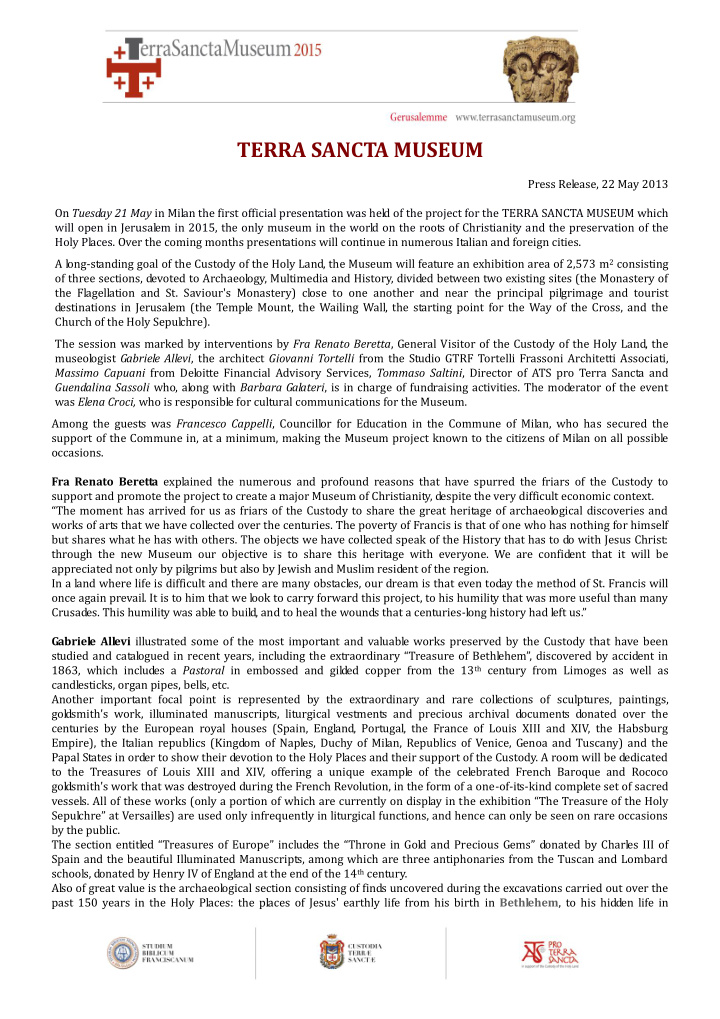



TERRA SANCTA MUSEUM Press Release, 22 May 2013 On Tuesday 21 May in Milan the first official presentation was held of the project for the TERRA SANCTA MUSEUM which will open in Jerusalem in 2015, the only museum in the world on the roots of Christianity and the preservation of the Holy Places. Over the coming months presentations will continue in numerous Italian and foreign cities. A long-standing goal of the Custody of the Holy Land, the Museum will feature an exhibition area of 2,573 m 2 consisting of three sections, devoted to Archaeology, Multimedia and History, divided between two existing sites (the Monastery of the Flagellation and St. Saviour's Monastery) close to one another and near the principal pilgrimage and tourist destinations in Jerusalem (the Temple Mount, the Wailing Wall, the starting point for the Way of the Cross, and the Church of the Holy Sepulchre). The session was marked by interventions by Fra Renato Beretta , General Visitor of the Custody of the Holy Land, the museologist Gabriele Allevi , the architect Giovanni Tortelli from the Studio GTRF Tortelli Frassoni Architetti Associati, Massimo Capuani from Deloitte Financial Advisory Services, Tommaso Saltini , Director of ATS pro Terra Sancta and Guendalina Sassoli who, along with Barbara Galateri , is in charge of fundraising activities. The moderator of the event was Elena Croci, who is responsible for cultural communications for the Museum. Among the guests was Francesco Cappelli , Councillor for Education in the Commune of Milan, who has secured the support of the Commune in, at a minimum, making the Museum project known to the citizens of Milan on all possible occasions. Fra Renato Beretta explained the numerous and profound reasons that have spurred the friars of the Custody to support and promote the project to create a major Museum of Christianity, despite the very difficult economic context. “The moment has arrived for us as friars of the Custody to share the great heritage of archaeological discoveries and works of arts that we have collected over the centuries. The poverty of Francis is that of one who has nothing for himself but shares what he has with others. The objects we have collected speak of the History that has to do with Jesus Christ: through the new Museum our objective is to share this heritage with everyone. We are confident that it will be appreciated not only by pilgrims but also by Jewish and Muslim resident of the region. In a land where life is difficult and there are many obstacles, our dream is that even today the method of St. Francis will once again prevail. It is to him that we look to carry forward this project, to his humility that was more useful than many Crusades. This humility was able to build, and to heal the wounds that a centuries-long history had lef t us.” Gabriele Allevi illustrated some of the most important and valuable works preserved by the Custody that have been studied and catalogued in recent years, including the extraordinary “Treasure of Bethlehem”, discovered by accident in 1863, which includes a Pastoral in embossed and gilded copper from the 13 th century from Limoges as well as candlesticks, organ pipes, bells, etc. Another important focal point is represented by the extraordinary and rare collections of sculptures, paintings, goldsmith's work, illuminated manuscripts, liturgical vestments and precious archival documents donated over the centuries by the European royal houses (Spain, England, Portugal, the France of Louis XIII and XIV, the Habsburg Empire), the Italian republics (Kingdom of Naples, Duchy of Milan, Republics of Venice, Genoa and Tuscany) and the Papal States in order to show their devotion to the Holy Places and their support of the Custody. A room will be dedicated to the Treasures of Louis XIII and XIV, offering a unique example of the celebrated French Baroque and Rococo goldsmith's work that was destroyed during the French Revolution, in the form of a one-of-its-kind complete set of sacred vessels. All of these works (only a portion of which are currently on display in t he exhibition “The Treasure of the Holy Sepulchre” at Versailles) are used only infrequently in liturgical functions, and hence can only be seen on rare occasions by the public. The section entitled “Treasures of Europe” includes the “Throne in Gold and Precious Gems” donated by Charles III of Spain and the beautiful Illuminated Manuscripts, among which are three antiphonaries from the Tuscan and Lombard schools, donated by Henry IV of England at the end of the 14 th century. Also of great value is the archaeological section consisting of finds uncovered during the excavations carried out over the past 150 years in the Holy Places: the places of Jesus' earthly life from his birth in Bethlehem , to his hidden life in
Recommend
More recommend